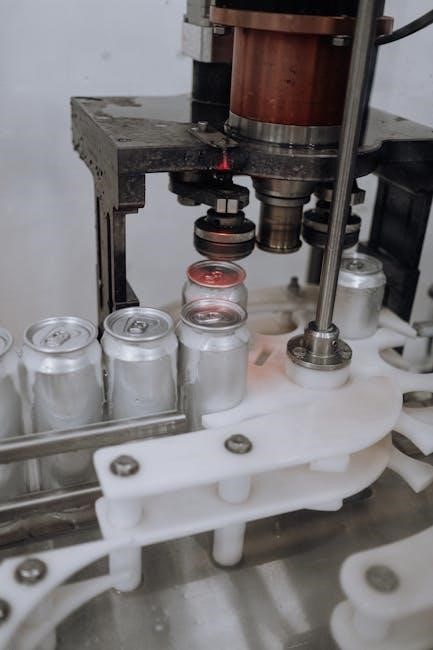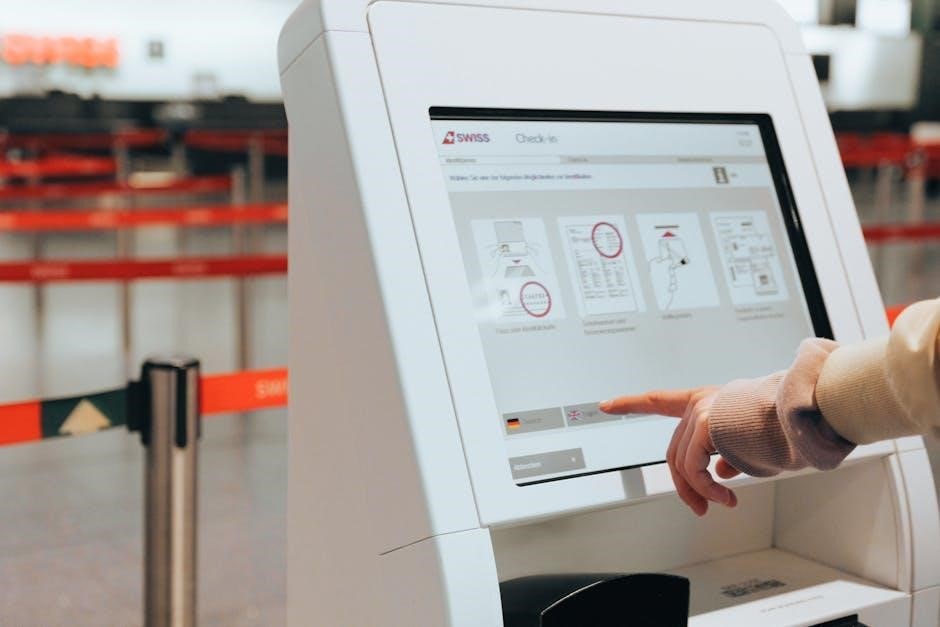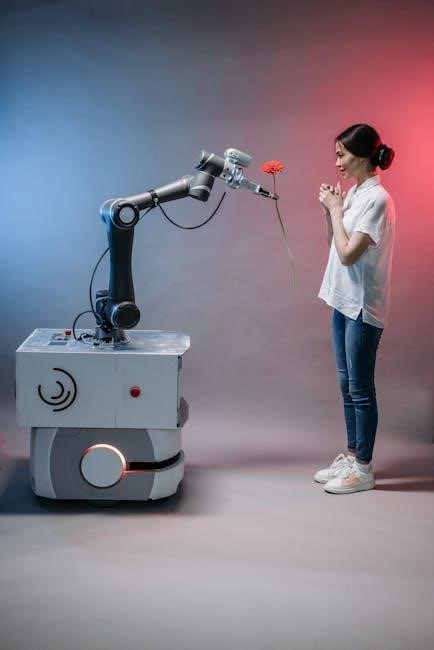The automation paradox highlights how automation, meant to enhance efficiency, often introduces complexities, challenging the balance between human expertise and machine capabilities.
1.1. Definition and Overview
The automation paradox refers to the contradiction where technological advancements, designed to simplify tasks, often introduce new complexities. While automation aims to enhance efficiency and reduce human intervention, it simultaneously reveals the limitations of relying solely on machines. This paradox underscores the delicate balance between technological progress and human oversight, emphasizing that automation, while powerful, is not a standalone solution. It requires human expertise to manage its implementation and address unforeseen challenges, ultimately highlighting the interdependence of technology and human capabilities.
1.2. Historical Context and Relevance
The automation paradox has roots in historical industrial shifts, where technological advancements initially disrupted workflows. Early studies, such as those from 2020 and 2017, explored how automation promised efficiency but revealed human limitations. Historical examples, like manufacturing automation, showed job displacement alongside productivity gains. This duality underscores the paradox’s enduring relevance. Today, discussions around AI and ethical considerations highlight how the paradox evolves, emphasizing the need to balance innovation with human-centric approaches to avoid repeating past challenges and ensure equitable progress in an increasingly automated world.

Understanding the Automation Paradox
The automation paradox reveals the tension between technological advancements and human limitations, highlighting how efficiency gains often coexist with unexpected challenges and complexities in implementation.
2.1. The Role of Technology in Automation
Technology is the cornerstone of automation, enabling machines and systems to perform tasks with precision and speed. Advances in AI, machine learning, and robotics have revolutionized industries, allowing for unprecedented efficiency. However, as automation progresses, it reveals a paradox: while technology enhances productivity, it also demands human oversight to address complexities and errors. This interplay underscores the dual nature of automation, where technological advancements coexist with the need for human expertise to navigate unpredictable scenarios and ensure reliable outcomes. Balancing these elements is crucial for maximizing the benefits of automation.
2.2. The Concept of Paradox in Automation
The automation paradox arises from the contradiction between the intended benefits of automation and its unintended consequences. While automation aims to streamline processes and reduce human error, it often introduces complexity and reliance on human intervention. This paradox is evident in scenarios where overly automated systems fail to account for unpredictable variables, leading to inefficiencies. The crux lies in the balance between machine efficiency and human adaptability, highlighting the need for systems that complement rather than replace human capabilities, ensuring resilience and adaptability in dynamic environments. This balance is crucial for sustainable automation solutions.
2.3. The Balance Between Efficiency and Human Limitations
Automation often seeks to maximize efficiency but can overlook human limitations, creating a paradox. While machines excel in repetitive tasks, humans provide creativity and adaptability. Over-reliance on automation may lead to systems that are too complex for humans to manage effectively, negating efficiency gains. Striking a balance requires designing systems that leverage machine strengths while preserving human oversight and decision-making capabilities. This ensures that automation enhances rather than hinders productivity, acknowledging both technological potential and human expertise as complementary elements in achieving sustainable progress and innovation. Balancing these elements is key to resolving the paradox.

The Paradox Explained
Automation aims to boost efficiency but often creates complexity, revealing a paradox where technological advancements clash with persistent human limitations, challenging expectations of seamless progress.
3.1. Technological Advancements vs. Human Limitations
The automation paradox reveals a striking contrast between rapid technological advancements and inherent human limitations. While automation aims to enhance efficiency and reduce errors, its effectiveness heavily depends on human acceptance and understanding. Technologies like GPT-4 demonstrate significant capabilities, yet their successful integration requires overcoming self-limiting beliefs and acquiring new skills. The introduction of concepts such as hierarchical autonomous agent swarms (HOS) underscores the potential for advanced automation, but it also emphasizes the need to address ethical and operational challenges to ensure harmonious human-machine collaborations. Balancing innovation with human adaptability remains crucial for effectively harnessing automation’s full potential.
3.2. Economic Implications of Automation
Automation presents a dual-edged economic impact, promising increased productivity and cost savings while risking job displacement and income inequality. As technologies like AI enhance efficiency, they also reshape labor markets, potentially marginalizing certain sectors. The paradox emerges as automation aims to drive economic growth but may destabilize livelihoods. Addressing these challenges requires strategic policies and investments in education to ensure equitable benefits and mitigate adverse effects on employment and economic stability.
3.3. The Impact on Job Markets and Employment
Automation significantly influences job markets by displacing certain roles while creating new opportunities. Traditional jobs may diminish as machines assume repetitive tasks, yet specialized skills in AI and technology emerge. The paradox lies in this duality—automation drives efficiency but disrupts employment structures. Workers must adapt, acquiring skills for evolving roles. Educational systems and retraining programs become crucial to mitigate unemployment and ensure a workforce aligned with technological advancements, balancing innovation with labor market needs for sustainable economic growth and social stability.

The Role of Artificial Intelligence in Automation
AI enhances automation by optimizing processes through smart systems and data analysis, yet raises ethical concerns, requiring careful balance between technological advancement and human oversight.
4.1. AI-Driven Automation and Its Challenges
AI-driven automation revolutionizes industries by enhancing efficiency and decision-making, yet faces challenges like data bias, ethical dilemmas, and job displacement, requiring robust governance and ethical frameworks.
4.2. The Potential of AI to Enhance Automation
AI enhances automation by optimizing processes, improving accuracy, and enabling real-time decision-making. Advanced algorithms handle complex tasks, from data analysis to predictive maintenance, boosting efficiency. AI-driven systems adapt to dynamic environments, scaling operations seamlessly. This transformative potential reshapes industries, fostering innovation and productivity while maintaining precision. The integration of AI ensures smarter, more agile automation solutions, aligning with evolving demands and driving technological progress forward.
4.3. Ethical Considerations in AI-Driven Automation
AI-driven automation raises significant ethical concerns, including bias in decision-making, job displacement, and accountability for errors. Ensuring transparency and fairness in AI systems is critical to address these issues. Additionally, the potential for data privacy breaches and the lack of human oversight in automated processes pose moral dilemmas. Ethical frameworks and regulations are essential to guide responsible AI development and deployment, balancing innovation with societal well-being and ensuring that automation benefits all stakeholders equitably.

Case Studies of the Automation Paradox
Historical examples, like the Industrial Revolution, and modern instances in manufacturing reveal the paradox: automation increases efficiency but often introduces unforeseen challenges, reshaping work and society.
5.1. Historical Examples of Automation Paradox
The Industrial Revolution exemplifies the automation paradox, as machines replaced human labor, promising efficiency but causing widespread unemployment and social unrest. The Luddites, protesting against machinery, highlighted the tension between technological progress and human livelihoods. Early automation in manufacturing showcased how increased productivity often led to job displacement, forcing workers to adapt to new roles. This historical pattern underscores the paradox’s enduring relevance, where technological advancements simultaneously solve and create complex societal challenges.
5.2. Modern-Day Case Studies
Modern examples of the automation paradox are evident in industries like manufacturing and transportation. Self-driving cars, for instance, promise enhanced safety and efficiency but raise ethical dilemmas and job displacement concerns. Similarly, AI-driven automation in customer service improves response times but risks dehumanizing interactions. These cases illustrate how technological advancements can simultaneously solve old problems and introduce new complexities, emphasizing the need for strategies to mitigate negative impacts while harnessing innovation’s potential.

5.3. Lessons Learned from Real-World Applications
Real-world applications of automation reveal critical insights into its implementation. Organizations must balance technological advancements with human oversight to avoid unintended consequences. Continuous monitoring and adaptability are essential to address emerging challenges. Additionally, fostering collaboration between humans and machines ensures that automation complements rather than replaces human capabilities. These lessons underscore the importance of ethical frameworks, robust policies, and ongoing education to maximize automation’s benefits while mitigating its risks.

Addressing the Paradox
Addressing the automation paradox requires balancing technological advancements with ethical practices, ensuring policies prioritize human well-being while maximizing efficiency and innovation.
6.1. Ethical Considerations and Responsible Innovation
Ethical considerations in automation emphasize transparency, fairness, and accountability. Responsible innovation ensures technologies like AI are developed with safeguards to prevent bias and protect human rights. Balancing efficiency with ethical practices is crucial.
6.2. Policy and Regulatory Challenges
Policy and regulatory challenges arise as automation disrupts traditional frameworks. Governments face balancing innovation with protecting workers’ rights and ensuring public safety. Existing laws often lag behind technological advancements, requiring updates to address AI-driven automation effectively.
6.3. The Role of Education and Skill Development
Addressing the automation paradox requires a focus on education and skill development. As machines assume routine tasks, workers must acquire skills that complement automation, such as critical thinking and creativity. Educational systems need to evolve, emphasizing lifelong learning and adaptability. Governments and industries should collaborate to provide training programs that prepare workers for emerging roles. Upskilling and reskilling are essential to ensure that the workforce remains relevant in an increasingly automated world, fostering resilience and enabling individuals to thrive alongside technological advancements.

The Future of Automation
The future of automation lies in balancing technological advancements with human collaboration, addressing ethical dilemmas and fostering innovation while ensuring equitable benefits for society.
7.1. Emerging Trends in Automation Technology
Emerging trends in automation technology include advanced AI-driven systems, predictive analytics, and seamless human-AI collaboration. These innovations aim to optimize efficiency while addressing ethical concerns. The integration of machine learning algorithms and IoT devices is revolutionizing industries, enabling real-time decision-making and adaptive automation solutions. Additionally, the development of autonomous systems and swarm intelligence is pushing the boundaries of what automation can achieve, creating both opportunities and challenges for the future workforce. These trends underscore the need for continuous innovation and ethical frameworks to guide their implementation.
7.2. The Potential for Human-AI Collaboration
Human-AI collaboration offers immense potential to bridge the gaps in automation. By leveraging AI’s analytical prowess and humans’ creative problem-solving, industries can achieve unprecedented efficiency. AI can assist in identifying self-limiting beliefs, enhancing decision-making, and generating solutions. This synergy allows humans to focus on high-value tasks, while AI handles repetitive and complex computations. The collaboration fosters innovation and adaptability, addressing the paradox by ensuring technology complements rather than replaces human capabilities, thus creating a balanced and ethical approach to automation.
7.3. The Path Forward: Balancing Automation and Human Needs
The path forward requires balancing automation with human needs, ensuring ethical frameworks guide technological advancements. By fostering collaboration and continuous learning, societies can adapt to automation’s challenges. Ethical considerations, such as transparency and fairness, must be prioritized to avoid exacerbating inequalities. Policymakers and educators play a crucial role in preparing workforces for evolving roles. The focus should be on enhancing human capabilities alongside automation, creating a harmonious integration that benefits both individuals and societies. This balanced approach will unlock automation’s potential while preserving human dignity and relevance in the future workforce.
The automation paradox underscores the delicate balance between technological progress and human needs, emphasizing the importance of ethical frameworks to guide future advancements and ensure societal harmony.

8.1. Summary of Key Points
The automation paradox revolves around the tension between technological advancements and human limitations, where increased efficiency often leads to unforeseen complexities. While automation aims to enhance productivity, it simultaneously challenges job markets and amplifies economic disparities. The paradox underscores the need for ethical frameworks, responsible innovation, and adaptive policies to navigate its implications. Education and skill development emerge as critical factors in preparing societies for an automated future. Ultimately, the paradox calls for a balanced approach that leverages technology while safeguarding human-centric values and employment opportunities.
8.2. Final Thoughts on the Automation Paradox
The automation paradox reminds us that technological progress, while transformative, is not without challenges. Balancing efficiency with human-centric values is crucial. As automation evolves, fostering collaboration between humans and machines, rather than competition, will be key. Ethical frameworks, adaptive policies, and continuous learning are essential to navigate this landscape. By addressing the paradox thoughtfully, society can harness automation’s benefits while mitigating its drawbacks, ensuring a future where technology complements human potential rather than overshadowing it.

References and Further Reading
Academic sources, industry reports, and recommended reading provide deeper insights into the automation paradox, offering theoretical frameworks and real-world applications for further exploration and understanding.
9.1. Academic Sources and Research Papers
Academic sources provide in-depth analysis of the automation paradox, offering empirical studies and theoretical frameworks. Research papers explore the balance between technological advancements and human limitations. Experts like AK Frison discuss societal benefits and user acceptance of automation in their works, highlighting its market establishment. These studies often examine the paradoxical outcomes, such as productivity gains versus job displacement, and ethical implications. They serve as foundational resources for understanding the complexities of automation, offering insights into its historical evolution and future trajectories. These papers are essential for scholars and professionals seeking to grasp the paradox’s multifaceted nature.
9.2. Industry Reports and Case Studies
Industry reports and case studies provide real-world insights into the automation paradox, offering practical examples of its implications. These documents often analyze specific sectors, such as manufacturing or IT, where automation has significantly impacted workflows. Case studies highlight both the benefits and challenges, showcasing how companies navigate technological advancements while addressing workforce concerns. For instance, reports on AI-driven automation detail efficiency gains but also note job displacement risks. These resources serve as valuable tools for businesses and policymakers, offering data-driven perspectives on automation’s dual nature and its impact on industries and economies.
9.3; Recommended Reading for Deeper Understanding
For a deeper understanding of the automation paradox, key readings include academic papers like AK Frison’s 2020 study on user acceptance and market establishment of automation. Industry reports from leading firms and think tanks provide data-driven insights into real-world applications. Additionally, works exploring AI ethics, such as those discussing OpenAI’s Agent Swarm project, offer perspectives on hierarchical autonomous systems. These resources collectively bridge theory and practice, enabling readers to grasp the paradox’s complexities and its implications for technology and society. They are essential for scholars, professionals, and policymakers seeking comprehensive knowledge on the subject.


